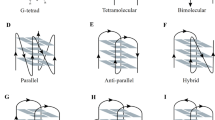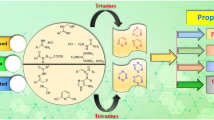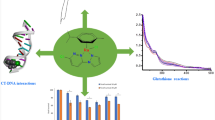Abstract
A new artificial nucleoside 2 comprising 4-(2′-pyridyl)imidazole as the nucleobase was devised and incorporated into a series of DNA oligonucleotide duplexes. The propensity of 2 to form metal-mediated homo and hetero base pairs was investigated in various 13mer and 26mer duplexes. The artificial nucleoside readily forms Ag(I)-mediated homo base pairs of the type 2–Ag(I)–2, in which the Ag(I) ion resides in a [2 + 2] coordination environment. In addition, the combination with the previously established imidazole nucleoside 1 leads to the formation of Ag(I)-mediated hetero base pairs (2–Ag(I)–1 and 1–Ag(I)–2) with a [2 + 1] coordination environment. With an increase in the melting temperature of ΔT m = 21.8 °C upon the formation of a Ag(I)-mediated base pair, the 2–Ag(I)–1 pair with the 13mer duplex is the most stabilizing Ag(I)-mediated base pair so far. Generally, the impact of the formation of a metal-mediated base pair on the properties of the DNA duplex was found to be significantly more prominent for shorter, intrinsically less stable duplexes.






Similar content being viewed by others
References
Müller J (2010) Metallomics 2:318–327
Müller J (2008) Eur J Inorg Chem: 3749–3763
Takezawa Y, Shionoya M (2012) Acc Chem Res 45:2066–2076
Clever GH, Kaul C, Carell T (2007) Angew Chem Int Ed 46:6226–6236
Ono A, Torigoe H, Tanaka Y, Okamoto I (2011) Chem Soc Rev 40:5855–5866
Katz S (1962) Nature 194:569
Megger DA, Megger N, Müller J (2012) Met Ions Life Sci 10:295–317
Clever GH, Shionoya M (2012) Met Ions Life Sci 10:269–294
Funai T, Nakamura J, Miyazaki Y, Kiriu R, Nakagawa O, Wada S-I, Ono A, Urata H (2014) Angew Chem Int Ed 53:6624–6627
Kim E-K, Switzer C (2013) ChemBioChem 14:2403–2407
Funai T, Miyazaki Y, Aotani M, Yamaguchi E, Nakagawa O, Wada S-I, Torigoe H, Ono A, Urata H (2012) Angew Chem Int Ed 51:6464–6466
Kaul C, Müller M, Wagner M, Schneider S, Carell T (2011) Nat Chem 3:794–800
Scharf P, Müller J (2013) ChemPlusChem 78:20–34
Mandal S, Hepp A, Müller J (2015) Dalton Trans 45:3540–3543
Megger DA, Fonseca Guerra C, Hoffmann J, Brutschy B, Bickelhaupt FM, Müller J (2011) Chem Eur J 17:6533–6544
Mei H, Inagle SA, Seela F (2014) Chem Eur J 20:16248–16257
Okamoto I, Iwamoto K, Watanabe Y, Miyake Y, Ono A (2009) Angew Chem Int Ed 48:1648–1651
Johannsen S, Paulus S, Düpre N, Müller J, Sigel RKO (2008) J Inorg Biochem 102:1141–1151
Ihara T, Ishii T, Araki N, Wilson AW, Jyo A (2009) J Am Chem Soc 131:3826–3827
Sinha I, Fonseca Guerra C, Müller J (2015) Angew Chem Int Ed 54:3603–3606
Müller J, Drumm M, Boudvillain M, Leng M, Sletten E, Lippert B (2000) J Biol Inorg Chem 5:603–611
Ono T, Yoshida K, Saotome Y, Sakabe R, Okamoto I, Ono A (2011) Chem Commun 47:1542–1544
Johannsen S, Megger N, Böhme D, Sigel RKO, Müller J (2010) Nat Chem 2:229–234
Kumbhar S, Johannsen S, Sigel RKO, Waller MP, Müller J (2013) J Inorg Biochem 127:203–210
Petrovec K, Ravoo BJ, Müller J (2012) Chem Commun 48:11844–11846
Litau S, Müller J (2015) J Inorg Biochem. doi:10.1016/j.jinorgbio.2015.1001.1004
Richters T, Müller J (2014) Eur J Inorg Chem: 437–441
Richters T, Krug O, Kösters J, Hepp A, Müller J (2014) Chem Eur J 20:7811–7818
Seubert K, Fonseca Guerra C, Bickelhaupt FM, Müller J (2011) Chem Commun 47:11041–11043
Hensel S, Megger N, Schweizer K, Müller J (2014) Beilstein J Org Chem 10:2139–2144
Rolland V, Kotera M, Lhomme J (1997) Synth Commun 27:3505–3511
Lancaster KM, Gerken JB, Durrell AC, Palmer JH, Gray HB (2010) Coord Chem Rev 254:1803–1811
Müller J, Böhme D, Lax P, Morell Cerdà M, Roitzsch M (2005) Chem Eur J 11:6246–6253
Sheldrick GM (2008) Acta Cryst A64:112–122
Sinha I, Kösters J, Hepp A, Müller J (2013) Dalton Trans 42:16080–16089
Weizman H, Tor Y (2001) J Am Chem Soc 123:3375–3376
Switzer C, Sinha S, Kim PH, Heuberger BD (2005) Angew Chem Int Ed 44:1529–1532
Weizman H, Tor Y (2001) Chem Commun: 453–454
Vorlíčková M, Kejnovská I, Bednářová K, Renčiuk D, Kypr J (2012) Chirality 24:691–698
Acknowledgments
Funding by the Deutsche Forschungsgemeinschaft (SFB 858) is gratefully acknowledged. We thank Alexandra Klaffki and Michael Kosse for performing initial studies at the onset of the project.
Author information
Authors and Affiliations
Corresponding author
Electronic supplementary material
Below is the link to the electronic supplementary material.
Rights and permissions
About this article
Cite this article
Schweizer, K., Kösters, J. & Müller, J. 4-(2′-Pyridyl)imidazole as an artificial nucleobase in highly stabilizing Ag(I)-mediated base pairs. J Biol Inorg Chem 20, 895–903 (2015). https://doi.org/10.1007/s00775-015-1274-2
Received:
Accepted:
Published:
Issue Date:
DOI: https://doi.org/10.1007/s00775-015-1274-2




